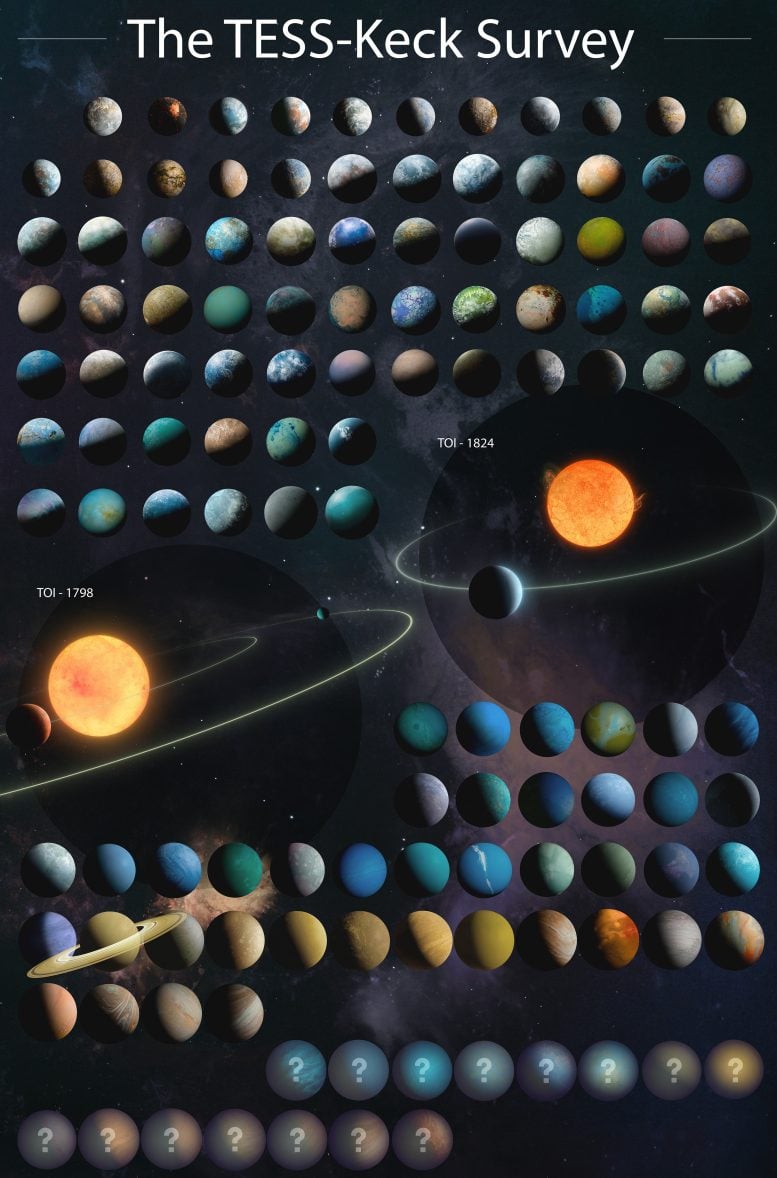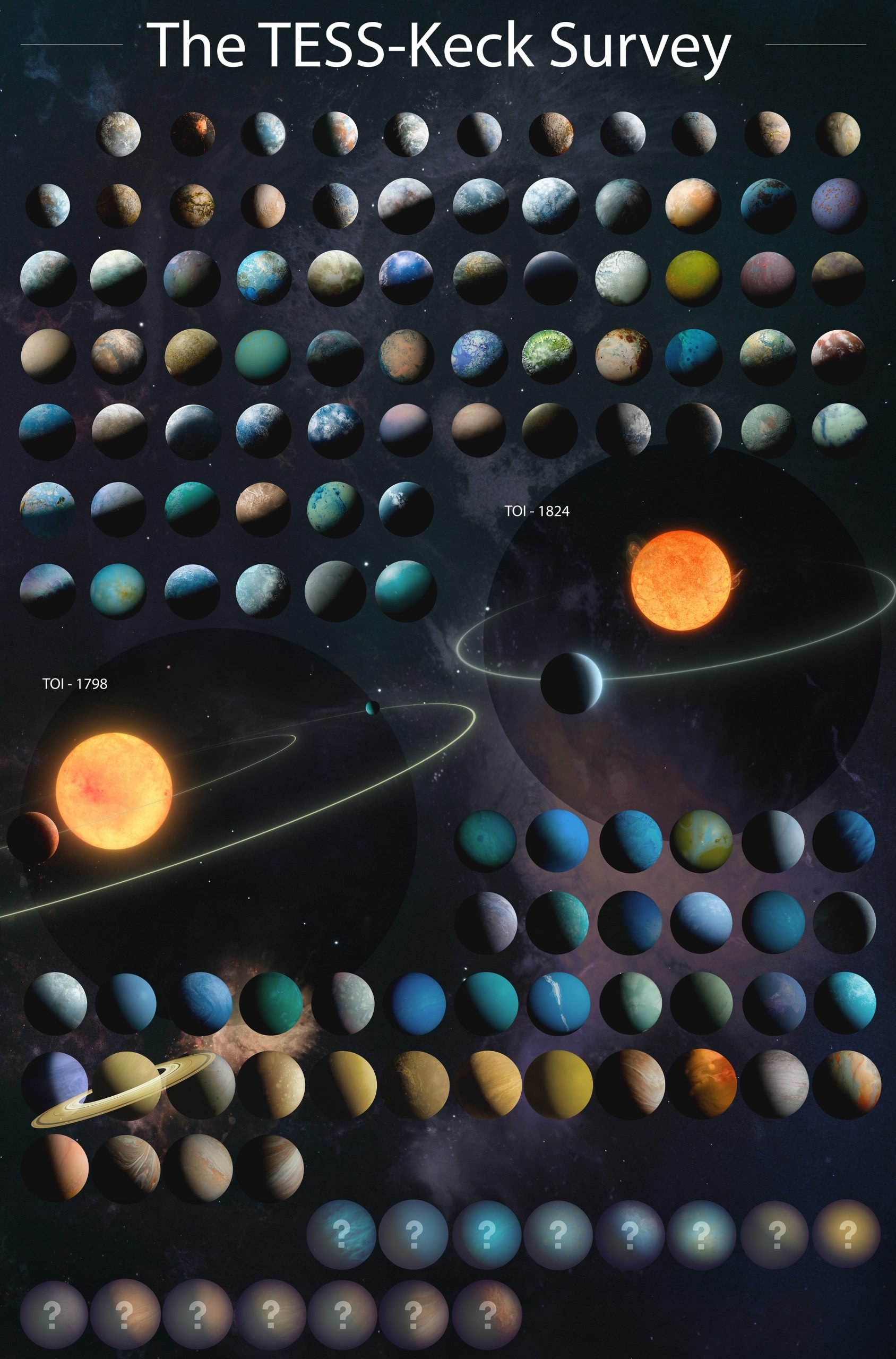Artist’s rendition of TOI-1798, a planetary system that is home to two planets. The new TESS-Keck Survey Mass Catalog shows the outer planet is a sub-Neptune with an orbital period of eight days; the inner planet is a strange Super-Earth that orbits so close to its star, one year on this alien world lasts only half an Earth day. Credit: W. M. Keck Observatory/Adam Makarenko
The NASA TESS-Keck Survey provides details on the mass and density of 126 planets.
Although thousands of planets have been discovered orbiting other stars, our understanding of them remains limited. A edition of The 
Artist conception of 126 planets in the latest TESS-Keck Survey catalog is based on data including planet radius, mass, density, and temperature. Question marks represent planets requiring more data for full characterization. Credit: W. M. Keck Observatory/Adam Makarenko
Though the planets themselves aren’t visible, they do have a visible effect. As they orbit, the planets tug on their host stars, causing them to “wobble.” When the star moves toward a telescope, its visible light turns slightly bluer; when it moves away from us, the light shifts slightly redder.
This is much like how sound behaves. Due to the Doppler effect, a fire truck’s siren gets higher-pitched as it travels closer and sounds lower-pitched as it drives farther away.
Understanding Planetary Systems Through Radial Velocity
“These RV measurements let astronomers detect and learn the properties of these exoplanetary systems. When we see a star wobbling regularly back and forth, we can infer the presence of an orbiting planet and measure the planet’s mass,” said Ian Crossfield, University of Kansas astrophysicist and catalog co-author.
Several planets in the TESS-Keck Survey stand out as touchstones for deepening astronomers’ understanding of the diverse ways planets form and evolve.
A related survey paper authored by UCR graduate student Michelle Hill announces the discovery of two new planets orbiting a star like our sun. The first is a “sub-describes a planet about half the size of Neptune that takes a mere 19 days to orbit its star, which is much like our Sun.
“Planets smaller than Neptune but larger than Earth are the most prevalent worlds in our galaxy, yet they are absent from our own Solar System. Each time a new one is discovered, we are reminded of how diverse our Universe is, and that our existence in the cosmos may be more unique than we can understand,” Pidhorodetska said.
There are a lot of stars that are not similar to our sun. If scientists want to make apt comparisons between our world and others, they need to find stars of a similar age, size, and mass. “Then we can do apples-to-apples comparisons,” Kane said. “That’s the exciting part of the papers produced by Michelle and Daria, because they allow for this.”
Planets with even more extreme, ultra-short orbits around stars unlike our sun are also detailed in the catalog. One is so close to its orange dwarf star it completes orbit in less than 12 hours.
“TOI-1798 c orbits its star so quickly that one year on this planet lasts less than half a day on Earth. Because of their proximity to their host stars, planets like this one are also ultra hot — receiving more than 3,000 times the radiation that Earth receives from the sun,” said Alex Polanski, University of Kansas physics and astronomy graduate student and lead author of the catalog paper.
“Existing in this extreme environment means that this planet has likely lost any atmosphere that it initially formed,” Polanski said.
Ultimately, this new catalog represents a major contribution both to NASA’s TESS mission, and toward answering the question of whether other planets are capable of hosting life as we know it.
“Are we unusual? The jury is still out on that one, but our new mass catalog represents a major step toward answering that question,” Kane said.
Reference: “The TESS-Keck Survey. XX. 15 New TESS Planets and a Uniform RV Analysis of All Survey Targets” by Alex S. Polanski, Jack Lubin, Corey Beard, Joseph M. Akana Murphy, Ryan Rubenzahl, Michelle L. Hill, Ian J. M. Crossfield, Ashley Chontos, Paul Robertson, Howard Isaacson, Stephen R. Kane, David R. Ciardi, Natalie M. Batalha, Courtney Dressing, Benjamin Fulton, Andrew W. Howard, Daniel Huber, Erik A. Petigura, Lauren M. Weiss, Isabel Angelo, Aida Behmard, Sarah Blunt, Casey L. Brinkman, Fei Dai, Paul A. Dalba, Tara Fetherolf, Steven Giacalone, Lea A. Hirsch, Rae Holcomb, Molly R. Kosiarek, Andrew W. Mayo, Mason G. MacDougall, Teo Močnik, Daria Pidhorodetska, Malena Rice, Lee J. Rosenthal, Nicholas Scarsdale, Emma V. Turtelboom, Dakotah Tyler, Judah Van Zandt, Samuel W. Yee, David R. Coria, Shannon D. Dulz, Joel D. Hartman, Aaron Householder, Sarah Lange, Andrew Langford, Emma M. Louden, Jared C. Siegel, Emily A. Gilbert, Erica J. Gonzales, Joshua E. Schlieder, Andrew W. Boyle, Jessie L. Christiansen, Catherine A. Clark, Rachel B. Fernandes, Michael B. Lund, Arjun B. Savel, Holden Gill, Charles Beichman, Rachel Matson, Elisabeth C. Matthews, E. Furlan, Steve B. Howell, Nicholas J. Scott, Mark E. Everett, John H. Livingston, Irina O. Ershova, Dmitry V. Cheryasov, Boris Safonov, Jorge Lillo-Box, David Barrado and María Morales-Calderón, 23 May 2024, The Astrophysical Journal Supplement Series.
DOI: 10.3847/1538-4365/ad4484











/https://tf-cmsv2-smithsonianmag-media.s3.amazonaws.com/filer_public/d1/82/d18228f6-d319-4525-bb18-78b829f0791f/mammalevolution_web.jpg)








Discussion about this post